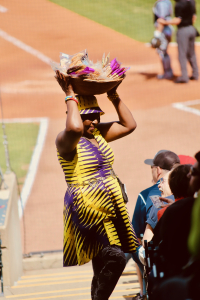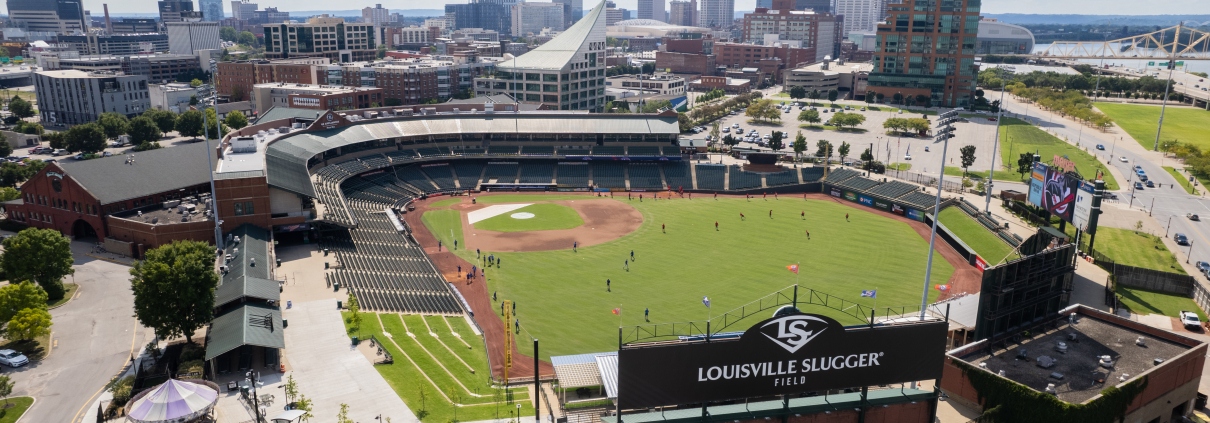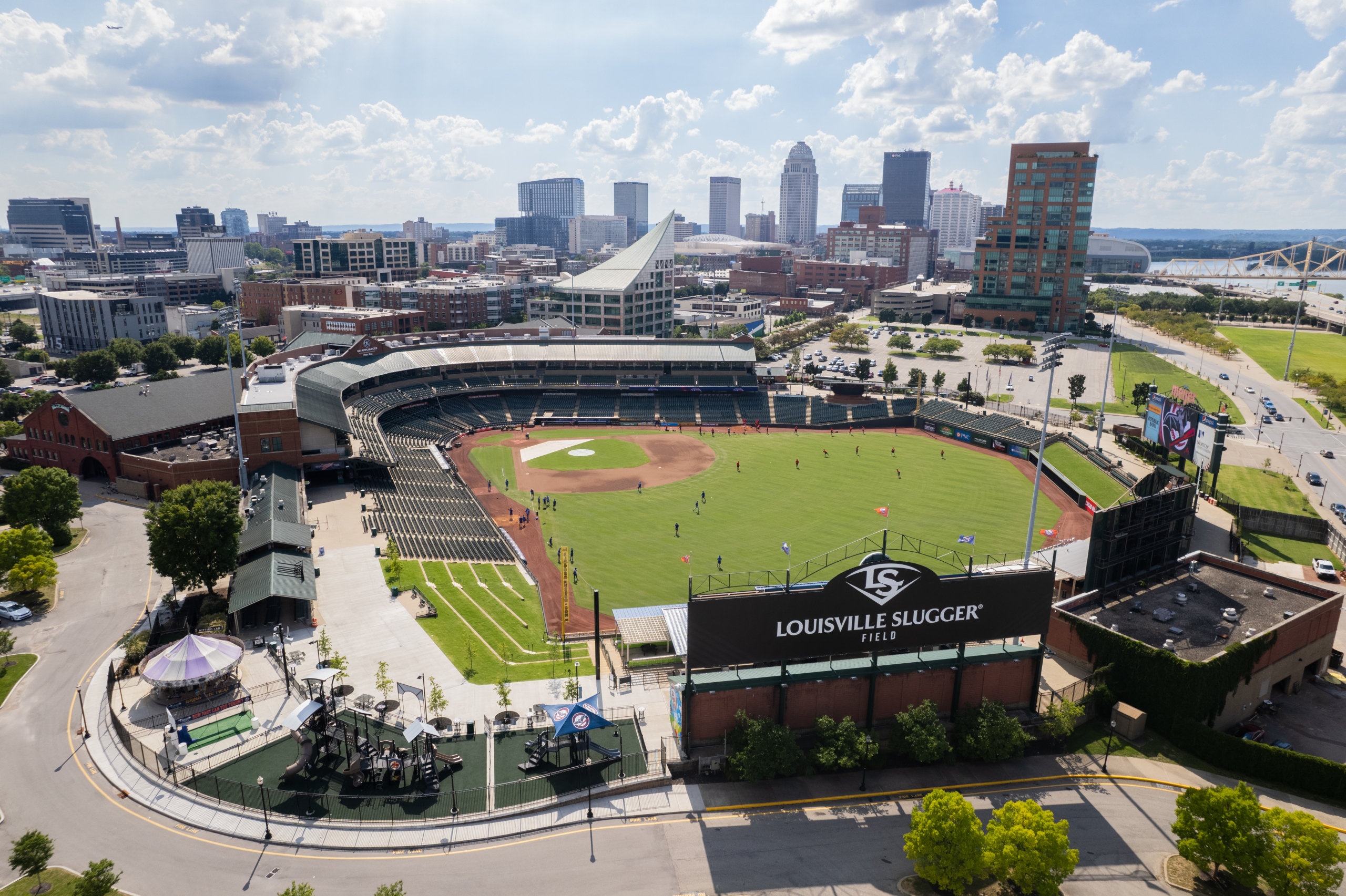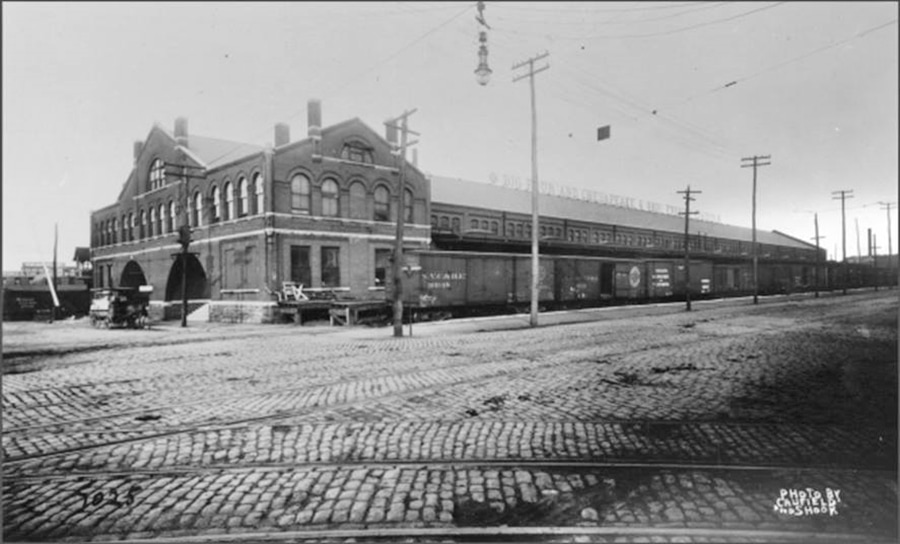Louisville Slugger Field (Louisville, KY)
This article was written by Abigail Miskowiec
Set amid concrete parking lots and crisscrossing interstate highway overpasses, Louisville Slugger Field seems a bit out of place. The red brick facade and arched windows overlooking Main Street and Preston Street in downtown Louisville, Kentucky, hark back to a time when railroads, not long-haul trucking, fueled the local economy. In the context of baseball history in Louisville – a charter member of the National League and home of the Louisville Slugger brand – the nod to the late 1800s feels appropriate.
While Louisville Slugger Field resembles other downtown ballparks of its era, particularly Coors Field and Camden Yards, its most prominent features stem from the site’s history as a train depot used by the Big Four and Chesapeake & Ohio railroad lines. The depot, which served as a major freight hub along routes to Cincinnati, St. Louis, Indianapolis, and Chicago, was part of a larger modernization movement occurring in downtown Louisville in the 1890s. The now-defunct Union Station of the Louisville & Nashville Railroad opened just two miles west of the Slugger Field site in 1891 and featured Romanesque architecture and immense stained-glass windows lauded as “the handsomest ever seen in the South.”1 Cherokee Park, one of many area parks designed by Frederick Law Olmsted, opened in 1892. The combination of recreation and retail in the downtown district caught the Big Four railroad’s eye, prompting the construction of the freight depot.
With such rapid development at the close of the 19th century, it came as little surprise when about 500 spectators materialized to bid bon voyage to the first freight train to depart the depot and cross the Big Four Bridge over the Ohio River into Jeffersonville, Indiana, on New Year’s Day in 1896.2 Business boomed to such an extent that the depot expanded to occupy a second full city block in 1907.3 Another expansion, led by the Big Four and Chesapeake & Ohio railroad companies, took place in 1917.4 That year, these additions enabled Louisville to process 5.6 million tons of incoming freight and distribute 3.1 million tons of outbound cargo.5
The introduction of the interstate system in the mid-20th century hurt railways nationwide6, and Louisville was no exception. By 1966, Interstates 64, 65, and 71 converged at “Spaghetti Junction” in downtown Louisville, which can be seen from Slugger Field today; these routes enabled trucking services to extend directly to St. Louis, Cincinnati, Chicago, and Mobile. The boom in trucking and decline in rail traffic coincided with the depot’s sale to the Brinly-Hardy lawn care company for use as a scrap yard and warehouse in 1964.7 Long after the last freight train departed, the building loomed “majestic but responsive… Arched windows linked in groups along the second level slide and hesitate like a trombone, while two wide, bow-legged entrance arches on the Preston Street facade pierce the massive masonry like booming drumbeats.”8
The site continued to serve as Brinly-Hardy’s warehouse when a push for a new baseball stadium arose in the late 1990s. Cardinal Stadium, the home of Louisville’s Triple-A Redbirds, had become a “dowdy facility, with a leaky grandstand and tattered turf.”9 The team had played at the cavernous multi-use site since the Redbirds relocated to Louisville from Springfield, Illinois, in 1982. The vast stadium, also the home of the University of Louisville football team, allowed Louisville to break the minor-league season attendance record with more than one million tickets sold in 1983, but as the 21st century approached, both city officials and club leadership sought a more up-to-date venue.
For the project, interested parties, led by Mayor Jerry Abramson, turned their attention to the downtown district. Louisville was investing in urban infrastructure and design in the 1990s, and the areas abutting the Ohio River that once resounded with the whistles of freight trains and shouts of merchants merited special focus. Waterfront Park, a sprawling greenspace along the banks of the river, broke ground in 199210, and the world’s tallest baseball bat, a 120-foot replica of Babe Ruth’s Louisville Slugger, began looming over Main Street when Hillerich & Bradsby Co. opened the Louisville Slugger Museum & Factory in 1996.11 Abramson sought to recapture the heyday of the city’s downtown area and declared the new stadium a “signature landmark” that would “tie downtown and the river together.”12
In 1997, Abramson announced the downtown stadium project at the train depot site; he worked closely with naming rights sponsor Hillerich & Bradsby, as well as local businesses and foundations, to finance the new stadium without levying any new taxes. The city purchased the property from Brinly-Hardy, which moved its facility across the river to Jeffersonville, Indiana. Louisville Scrap Material Company, another prominent tenant at the site, relocated to a venue two miles east of the ballpark along River Road, and worked with the city to clean up environmental contamination resulting from their processes. Between land acquisition and construction costs, the price tag was estimated at $34.2 million.13
A frenzy of activity enveloped Main and Preston Streets over the next two years. Construction crews dismantled the original train depot structure, but much of the material was preserved and reused in the stadium’s grand entryway.14 Even as the Louisville RiverBats prepared to face Norfolk in the home opener on April 12, 2000, board chair Dan Ulmer set to work snipping “loose wires and prongs” while construction crews raced to prepare the playing surface.15 Although the glistening downtown venue was still under construction when a sellout crowd surged into the stadium, Deion Sanders, perhaps the most notable name on the opening day roster and the first RiverBats player to cross the plate, sang the stadium’s praises. “It’s a wonderful facility,” he said. “I’ve been involved in a number of firsts in my life and I’m glad this is another first for me.”16
Construction crews did not complete the finishing touches until late July 2000, but the delays did not deter fans. In the first season at the new stadium, Louisville topped the International League in attendance, recording 685,561 fans, the team’s highest total since 1984. The team narrowly missed a .500 record with a loss to the rival Indianapolis Indians in the finale.17
The entryway, complete with steel trusses that pre-date Honus Wagner’s first major-league appearance, towers over entering fans. 18 The converted warehouse houses the Hall of Fame Pavilion, which recognizes the long baseball tradition of Louisville and Kentucky as a whole. Banners honoring past pennant winners grace pillars, and a black-and-white photograph of Parkway Field, outlined in bricks from the bygone stadium, adorns a wall.19 The space regularly hosts birthday parties, weddings, and other events.
Fans passing through the Hall of Fame Pavilion enter the two-tiered seating area. The lower level stretches from left field to partway down the right-field line, and a smaller upper deck spans the distance between first and third base. This upper level includes two luxury suites, an air-conditioned lounge area, and club-level seating. Two grassy areas – a berm in left-center and a three-tiered stretch of the right-field line – offer general admission seating. The outfield concourse provides entertainment for adults and children, alike, with a shaded picnic area, playground, carousel, and tap house. When the stadium opened in 2000, the seating capacity was 13,131, but the removal of seats in the early 2020s to accommodate a grassy gathering area along the right-field line reduced the capacity to approximately 11,500 (10,000 seats and 1,500 general admission), according to the club. The field’s dimensions are 325 feet to left, 385 to left-center, 405 to center, 375 to right-center, and 340 to right.
Slugger Field’s familiar sights and cast of eclectic characters have been in place from the beginning. A statue of Kentucky native Pee Wee Reese turning a double play has welcomed fans since mid-2000, and a statue of football star “Golden Boy” Paul Hornung, a proud son of Louisville, has towered over the riverside entrance since 2006.20 Alongside these familiar faces, sweet strains of organ music and calls of vendors have remained consistent at the stadium. Bob Ramsey, the club’s organist from the Cardinal Stadium days, adapted through the years. The ponytailed mainstay nearly found himself out of a job as baseball increasingly invested in digital music and flashy videos. In an interview with LEO Weekly, a local alternative newspaper, Ramsey reflected on his journey. He asked the team to let him ‘“play the computer,’ and they did. As of 2023, Ramsey choreographs all the sound and sight images fans see on the scoreboard, plus the organ.”21 Ramsey took center stage in 2023 during a “Nothing Night,” a promotion that featured no recorded music, just Ramsey’s organ playing.22
For more than 20 years, one voice rose above the din of the crowd. Elizabeth Kizito, who emigrated from Uganda to Louisville in the 1970s, began weaving effortlessly through the crowd with a basket of her signature “Kizito Cookies” on her head when Slugger Field opened in 2000. The team memorialized the iconic “cookie lady” and her homemade cookies in 2019 when the Bats featured a Kizito bobblehead giveaway.23


On the field, Louisville experienced success almost immediately. In 2001, slugger Adam Dunn powered the team to an 84-60 record, good for third best in the International League. With IL Hall of Famer Dave Miley at the helm, the RiverBats pressed their way into the Governors’ Cup playoffs. On September 10, Louisville edged out Scranton/Wilkes-Barre on captain Chris Sexton’s go-ahead bases-loaded walk in the seventh inning. Due to the next morning’s terrorist attacks, though, the series was canceled, and the RiverBats were declared the league champions on September 12.24
The product on the field has been middle-of-the-road for much of the Bats’ first two decades at Slugger Field. As of 2023, the team had never thrown a no-hitter in the stadium and last made the playoffs in 2009. Regardless of the team’s success, a number of notable future Reds called Louisville home before getting the call to the big leagues. The 2007 team, in particular, featured Joey Votto, Jay Bruce, Edwin Encarnación, and Johnny Cueto, all of whom garnered All-Star honors multiple times in their major-league careers.
The most lauded and successful athletes to grace the grass – Bermuda, an ironic choice for the bluegrass state – at Slugger Field have been members of Louisville City Football Club, or “LouCity,” which began play in 2015. Before the “boys in purple” could dominate the United Soccer League Championship, ownership had to solve the many issues inherent in converting a baseball stadium to a soccer pitch.25 Would the sightlines allow for fan engagement and excitement? How would the grounds crew deal with dirt basepaths? How would LouCity and the Bats manage their schedules?
One potential roadblock vexed Wayne Estopinal, a majority owner of LouCity and a local architect. The pitcher’s mound’s 10-inch height nearly became an insurmountable challenge. Other dual-use stadiums employed hydraulic lifts, which come with a price tag of approximately $400,000. Estopinal devised a system of screw jacks attached to a motor that saved the organization both time and money.26 The new system, which Estopinal estimated at a price tag of $165,000, could reset the mound in as little as nine minutes.27 The Esto Retractable system has since been installed at several other multi-use venues, including Globe Life Field, home of the Texas Rangers and site of the 2020 World Series.28
The tremendous efforts and innovation were well worth it. LouCity made the Eastern Conference Finals in each of their first eight seasons and won back-to-back USL championships in 2017-18. The LouCity faithful packed Slugger Field for the championship game in 2017; the 14,456 in attendance briefly held the record for largest sports crowd at the stadium until the Bats logged 14,658 fans who stayed late to watch the “Thunder Over Louisville” fireworks show on April 21, 2018.2930 The soccer club closed its time at Slugger Field on October 12, 2019, with an 8-3 rout over the Swope Park Rangers. The next year Louisville City moved to Lynn Family Stadium, a purpose-built soccer stadium that also hosts the Racing Louisville Football Club in the National Women’s Soccer League.
Aside from sports, Slugger Field has played host to a number of concerts, political rallies, and community events. In 2008, a record-setting 18,543 people crowded into the stadium to see Dave Matthews Band with a guest appearance by Willie Nelson.31 Barack Obama spoke at the stadium in 2006, mere months before declaring his candidacy for president, and Hillary Clinton stumped at Slugger Field in the run-up to the 2016 election.3233 The stadium has even become a shelter in times of need, hosting a fundraiser for evacuees from Hurricane Katrina in 2005 and functioning as a command center for first responders during the Old National Bank shooting in 2023.3435
In the 2020s, the Bats further invested in their future in Louisville and renewed their lease with the city until 2038. President Gary Ulmer, son of and successor to Dan Ulmer, who had brought professional baseball back to Louisville in 1982 and envisioned Louisville Slugger Field in the late 1990s, turned his attention to securing funds for upgrades, and Louisville Metro Council signed off on an $8 million investment in mid-2019.36 In the midst of the COVID-19 pandemic and canceled season of 2020, team ownership took the opportunity to invest in bringing the stadium up to date. Louisville focused on improving the weight room and locker room areas to comply with new MLB guidelines.37 The Bats also added a children’s play area and two bars to the concourse, as well as new LED video boards and expanded safety netting.38
“If there’s anything positive that came out of the COVID-19 pandemic for us, and not having baseball being played in our stadium for an entire year, it was the fact that the construction and renovation just went on every day uninterrupted,” team president Greg Galiette, who succeeded Gary Ulmer following the 2020 season, said. “Now, instead of this project being done in the spring of 2022, it’s now going to be done here in the middle of August [2021].”39
Louisville Slugger Field celebrated the new additions by hosting the big-league club as the Reds’ alternate training site in 2021.40 With the start of the Triple-A season delayed until May, Louisville fans had the opportunity to watch players on Cincinnati’s 40-man roster face off in scrimmages against alternate training site teams from Cleveland, Kansas City, and Pittsburgh.
Just as the Ulmers and Mayor Abramson envisioned, Louisville Slugger Field has become a cornerstone of a blossoming downtown. The stadium itself has hosted a number of restaurants over its history, most recently housing Against the Grain Brewery and Smokehouse, which was Louisville’s first brewer-owned and -operated brewery when it opened in 2011.41 Arts organizations, such as the Louisville Ballet, and major sports venues, such as the KFC Yum! Center indoor arena, reside within a half mile of the stadium, and the surrounding blocks boast at least half a dozen bourbon distilleries and countless restaurants. As traffic speeds by on Main Street and the interstates, Slugger Field stands tall as a measure of downtown revitalization.
Last revised: August 1, 2023
Acknowledgments
This story was reviewed by Kurt Blumenau and Rory Costello and fact-checked by David Kritzler.
Photo credits
Drone photo and Elizabeth Kizito: courtesy of the Louisville Bats.
Depot – Caufield & Shook. CS 007025. 1913. Archives & Special Collections, University of Louisville, Louisville.
Notes
1 “Finest in the South,” The Courier-Journal, July 18, 1891: 8.
2 “A Good Start,” The Courier-Journal, January 2, 1896: 3.
3 “New Freight Depot,” The Courier-Journal, September 6, 1906: 10.
4 “Another Terminal Warehouse to Cost $475,000 Planned by Roads,” The Courier-Journal, February 7, 1917: 10.
5 C.B. Stafford, “Where Man’s Handiwork Spans the Mighty Ohio,” The Courier-Journal, March 12, 1918: B1.
6 According to the Association of American Railroads, railroads conveyed just 35% of intercity freight by 1978. “Chronology of America’s Freight Railroads,” Association of American Railroads, https://www.aar.org/wp-content/uploads/2020/07/AAR-Chronology-Americas-Freight-Railroads-Fact-Sheet.pdf, accessed June 21, 2023.
7 Ibid. “Throughout the 1950s and 1960s, the rapid growth of truck and barge competition (aided by tens of billions of dollars in federal funding for construction of the interstate highway and inland waterway systems) and huge ongoing losses in passenger operations led to more railroad bankruptcies, service abandonments, and deferred maintenance.”
8 Diane Heilenman, “Wailing Walls,” The Courier-Journal Magazine, December 6, 1987: 16.
9 Sheldon S. Shafer, “Aging Cardinal Stadium struggles for new identity,” The Courier-Journal, January 25, 1998: 3.
10 “Our Story,” Waterfront Park, https://ourwaterfront.org/about/our-story/, accessed May 10, 2023.
11 “Our History,” Louisville Slugger Museum & Factory, https://www.sluggermuseum.com/our-history, accessed May 10, 2023.
12 Sheldon S. Shafer, “Mayor: Stadium to be a ‘landmark,’” The Courier-Journal, July 31, 1997: 1.
13 Shafer, “Mayor: Stadium to be a ‘landmark.’”
14 Sheldon S. Shafer, “With foundation in place, Slugger Field starting to take shape,” The Courier-Journal, June 2, 1999: 4.
15 The team shortened its nickname to “the Bats” prior to the 2002 season.
16 Rick Bozich, “Opening night on Main Street works its magic,” The Courier-Journal, April 13, 2000: 1.
17 Brian Bennett, “Loss to Indians caps Bats’ season at 71-73,” The Courier-Journal, September 5, 2000: 30.
18 Wagner took the field for the Louisville Colonels on July 19, 1897, at Eclipse Park II just four miles from the site of Louisville Slugger Field. In three seasons with the Colonels, Wagner hit .322/.369/.457.
19 The Louisville Colonels earned back-to-back-to-back championships twice in the team’s existence (1944-46, 1960-62). With 18 titles – 15 as the Colonels, 3 as the Redbirds – Louisville is the winningest city in the league’s history. Nine of those clubs played at Parkway Field.
20 Billy Reed, “Golden Boy bronzed,” LEO Weekly, April 25, 2006, https://www.leoweekly.com/2006/04/golden-boy-bronzed-new-downtown-statue-memorializes-paul-hornung/, accessed June 11, 2023.
21 Bill Doolittle, “The music of baseball,” LEO Weekly, July 30, 2013, https://www.leoweekly.com/2013/07/the-music-of-baseball/, accessed June 11, 2023.
22 Brendan Samson, “Bats ready to get all worked up over ‘Nothing,’” Minor League Baseball, May 16, 2023, https://www.milb.com/news/louisville-bats-host-first-nothing-night, accessed June 21, 2023.
23 Kate Molck, “Buy Me Some Peanuts and… Kizito Cookies?” Louisville.com, August 22, 2019, https://archive.louisville.com/content/kizito-cookies-louisville-slugger-field-baseball, accessed June 11, 2023.
24 “Louisville Declared Triple-A Champion,” Philadelphia Inquirer, September 13, 2001: C8.
25 The United Soccer League (USL) Championship is a second-tier professional men’s soccer league. Similar to some minor leagues in baseball, the USL Championship features teams that are affiliated with Major League Soccer (MLS) as well as teams that are independent. Louisville City FC is not affiliated.
26 Jonathan Lintner, “Gadget to save team big bucks,” The Courier-Journal, February 27, 2015: C3.
27 Tim Sullivan, “Ex-LouCity owner solves mound issue: Platform evens out field for soccer,” The Courier-Journal, September 20, 2018: 1C.
28 “Projects,” Esto Retractable, https://www.estoretractable.com/projects, accessed June 11, 2023.
29 Danielle Lerner, “Cup Runneth Over: USL championship lands in Louisville,” The Courier-Journal, November 14, 2017: 1C.
30 Chris Chandler, “Louisville Bats set new attendance record,” WLKY, April 22, 2018, https://www.wlky.com/article/louisville-bats-set-new-attendance-record/19884669, accessed June 10, 2023.
31 Chandler, “Louisville Bats set new attendance record.”
32 Kay Stewart, “Obama: Vote offers choice,” The Courier-Journal, September 15, 2006: B1.
33 Joseph Gerth, “Hillary Clinton in Louisville,” The Courier-Journal, May 11, 2016: A9.
34 Kay Stewart. “Hurricane Katrina: The Recovery; Slugger Field Welcome,” The Courier-Journal, September 11, 2005: A11.
35 Katrina Nickell. “Louisville Bats honor victims of mass shooting in return to Slugger Field.” WDRB, April 18, 2023, https://www.wdrb.com/news/louisville-bats-honor-victims-of-mass-shooting-in-return-to-slugger-field/article_91b5eb80-de3d-11ed-839b-2ff9bb059b7e.html, accessed June 11, 2023.
36 Tim Sullivan. “Bats’ new lease adds $8M in renovations.” The Courier-Journal, July 30, 2019: B4.
37 During the pause in Minor League play, MLB restructured MiLB and began to enforce new facilities guidelines. For more, see Kevin Reichard, “MiLB facility guidelines released; owners sanguine,” Ballpark Digest, November 2, 2020, https://ballparkdigest.com/2020/11/02/milb-facility-guidelines-released-owners-sanguine/, accessed June 21, 2023.
38 Siera Jones. “The Bats still adjusting to virus-caused changes.” The Courier-Journal, July 26, 2021: B1.
39 Jones. “The Bats still adjusting to virus-caused changes.”
40 Major League Baseball used “alternate training sites” during the shortened 2020 season and the early months of the 2021 season to mitigate exposure to the COVID-19 pandemic. The proximity of these locations to the major-league team allowed players not on the 26-man roster to train and travel safely when called up.
41 “Our Story,” Against the Grain, https://atgbrewery.com/about/, accessed May 23, 2023.




